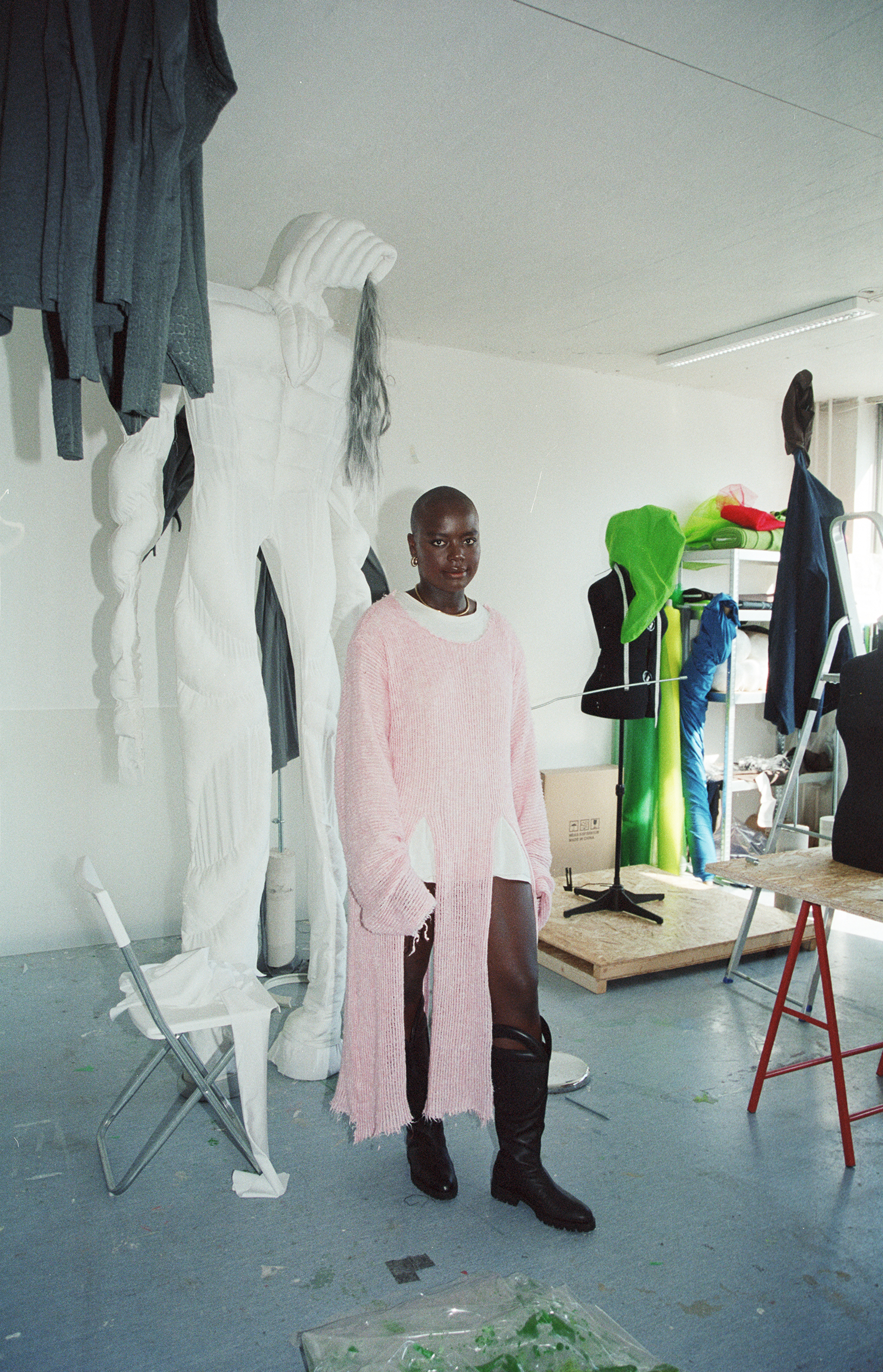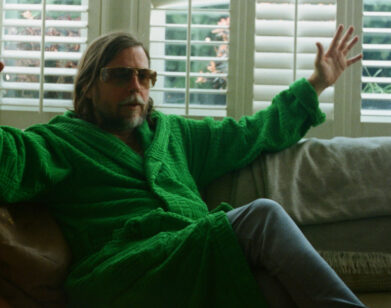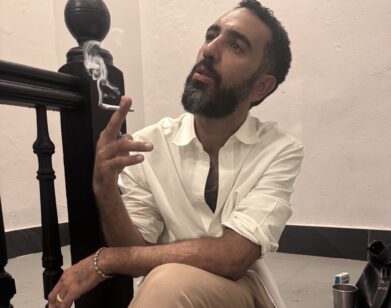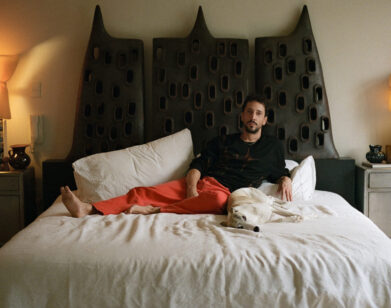in studio
Get to Know 5 Rising Art Stars From the New Museum Triennial

Bronwyn Katz. Photographed by Haneem Christian.
This fall, the New Museum Triennial brings the radical edge of a truly global art world to New York City. In honor of “Soft Water Hard Stone,” a transformative survey of emerging talent, we’ve asked five participating artists for their inspirations, aspirations, and aggravations.
———
Bronwyn Katz
Age: 27
Hometown: Kimberley, South Africa
Favorite color: Orange
Primary medium: Sculpture and installation
INTERVIEW: What formative experience led you to want to be an artist?
BRONWYN KATZ: My father worked as a metalworker when I was a child. I enjoyed watching him passionately design and make metal fences and swings. I was drawn to the process of creating, of bringing an idea to life.
INTERVIEW: Is New York City still the capital of the art world?
KATZ: I don’t think there is any real need for a capital of the art world. Capitals tend to create an unnecessary hierarchy of place.
INTERVIEW: Local or global? Where do you find inspiration?
KATZ: Both. The two are too interconnected to think of as separate.
INTERVIEW: Who is your favorite living artist?
KATZ: Mmakgabo Mmapula Mmangankato Helen Sebidi.
INTERVIEW: In a time of great social and political revolution, what is the role of art?
KATZ: It has the potential to create paths and portals to alternative worlds. It can open our eyes to a better future.
INTERVIEW: What do you do to clear your mind?
KATZ: I go for walks.
———
Brandon Ndife

Photograph by Tim Schutsky. Photography assistant: Steven Miner.
Age: 30
Hometown: Hammond, IN
Lives in: Brooklyn, NY
Favorite color: Moss green, Orange
Primary Practice: Mixed Media
INTERVIEW: What formative experience led you to want to be an artist?
BRANDON NDIFE: Two of my favorite artists were actually children’s book authors and illustrators—Eric Carle and Tomie dePaola. Their simple, clear style was very attractive to me.
INTERVIEW: How did you settle on your current medium?
NDIFE: My sculptures became an amalgamation of all my previous tendencies and interests over the years.
INTERVIEW: Is New York City still the capital of the art world?
NDIFE: I would say so. Although, the transition to post-pandemic times will be very interesting.
INTERVIEW: Local or global? Where do you find inspiration?
NDIFE: I keep both in mind in my practice. One certainly casts a shadow on the other and sometimes, they shift in terms of pertinence.
INTERVIEW: What would you like to change about the art world?
NDIFE: Less nepotism. I see friends starting to shift power around to those in the margins and that keeps me hopeful.
INTERVIEW: Who is your favorite living artist?
NDIFE: David Hammons.
INTERVIEW: What would you ask Andy Warhol if he were still alive?
NDIFE: How have we done so far?
INTERVIEW: In a time of great social and political revolution, what is the role of art?
NDIFE: An act of documentation that the human condition runs through all life.
INTERVIEW: What do you do to clear your mind?
NDIFE: Exercise. It really works. And you get to look like an idiot in public.
INTERVIEW: Describe your studio.
NDIFE: It functions like a laboratory. One Monstera clipping is drinking water out of a plastic cup, a few resin tests are on the side, rehydrating corn husks, experiments with different tactile strengths of expanding foams—it’s all very organic. I work very focused but very loose. I never dedicate to just one sculpture for any given moment.
———
Yu Ji

Photograph by Yufeng Yan.
Age: 36
Hometown: Shanghai, China
Favorite color: Concrete
Primary medium: Sculpture
INTERVIEW: What formative art experience led you to want to be an artist?
YU JI: Spending time in theaters and museums.
INTERVIEW: How did you settle on your current medium?
JI: Any material in our living world, easy and cheap, I get. I just follow my needs of expression.
INTERVIEW: Is New York City still the capital of the art world?
JI: I have never been to New York. I can answer after I check it out.
INTERVIEW: Who is your favorite artist of all time?
JI: Wilhelm Lehmbruck.
INTERVIEW: Who is your favorite living artist and why?
JI: Mark Manders. He is a poet who builds new worlds with objects and words.
INTERVIEW: What would you ask Andy Warhol if he were still alive?
JI: What do you think is the biggest limitation of being a human?
INTERVIEW: In a time of great social and political revolution, what is the role of art?
JI: Art is an excuse. Always.
INTERVIEW: What do you do to clear your mind?
JI: Sit on the mudflat near my house after midnight.
INTERVIEW: Describe your studio.
JI: Home.
INTERVIEW: What is your current studio soundtrack?
JI: The jazz album of Tom & Jerry.
———
Ann Greene Kelly

Photograph by Thomas Welch. Photography assistant: Ben Reed.
Age: 33
Hometown: New York City
Lives in: Los Angeles
Favorite color: Pink
Primary medium: Sculpture
INTERVIEW: What formative art experience led you to want to be an artist?
ANN GREENE KELLY: I don’t think there’s just one. For as long as I can remember, I have loved objects: art, clothes, music, images. I was lucky to grow up seeing art. I hated school, was a slow learner, and a bad student. I lacked the commitment for sports. Making stuff is the only thing that ever felt right for me. As a teenager, I appreciated the time I spent drawing and looking—it felt important despite the result or reaction. I could be immersed and find my own direction through the labor. There was nothing else that felt like that; it felt powerful.
INTERVIEW: Is New York City still the capital of the art world?
KELLY: It depends on what art world you want to be in.
INTERVIEW: What would you like to change about the art world?
KELLY: More support for artists, financial and social. There are so many artists who never have a chance to nurture their work because of the financial instability and systemic discrimination. We are all missing out on that work.
INTERVIEW: Who is your favorite artist of all time?
KELLY: Can’t have one without the others. I keep wanting to say Brâncuşi, but I think that’s because he’s so canonical. I don’t have one favorite, I need them all.
INTERVIEW: In a time of great social and political revolution, what is the role of art?
KELLY: I don’t know. I think it depends on what the revolution needs. The role of art seems like it will always be in flux. I think art is revolutionary; it offers shifts in perspective and it can happen outside of or around language, which is radical on large and small scales. It is important to have alternatives with imagination.
INTERVIEW: What do you do to clear your mind?
KELLY: Draw, run, drink, read, call my friends.
INTERVIEW: Describe your studio.
KELLY: Messy.
INTERVIEW: What is your current studio soundtrack?
KELLY: I go through stages. Right now it’s Iggy Pop, especially The Stooges’ first album, and Sudan Archives. I also listen to lots of fantasy books on tape.
———
Sandra Mujinga

Photograph by Maria Lyngnes.
Age: 32
Hometown: Goma, D.R. Congo
Lives in: Oslo, Norway
Favorite color: Something between warm turquoise blue and azure. Primary medium: Installation
INTERVIEW: What formative art experience led you to want to be an artist?
SANDRA MUJINGA: I had a very creative mother who understood that my young, shy self communicated through art, and I was encouraged to draw. I sometimes feel like ending up as an artist was something of an accident, as I always thought my creativity had to have some practical usefulness to it. Later, I wasn’t accepted into architecture studies, and a teacher straight-up asked me if I had considered applying to an art academy, and I did.
INTERVIEW: How did you settle on your current material/medium?
MUJINGA: I think of art as a space to host and connect these unthinkable interactions. It has always made sense to me to process materials through techniques that I have learned from working with other materials. Music becomes a tool to stretch time, and sculpture helps me to think about the flatness of things.
INTERVIEW: What project are you planning to show at this year’s New Museum Triennial?
MUJINGA: A three-channel video installation titled “Pervasive Light” (2021), where I made a green camouflage suit that blends into the green-screen background that has been transformed into darkness. By merging with the background, shapeshifting, and through evasive movements of the performer, the character avoids being caught by our gaze.
INTERVIEW: Where do you find inspiration?
MUJINGA: I find inspiration from everything, to be honest. It’s a cliché, but recently I have been very drawn to mesh fabrics on construction sites, and how they are laid out and organized for a function.
INTERVIEW: What would you like to change about the art world?
MUJINGA: Diversity and inclusivity on all levels.
INTERVIEW: What would you ask Andy Warhol if he were still alive?
MUJINGA: What do you think about Instagram?
INTERVIEW: In a time of great social and political revolution, what is the role of art?
MUJINGA: I think art has the potential to reimagine real lived experiences, and it structures and touches many lives. Art can lift up both humans and non-humans by giving space to rethink what is accepted and established, and to not be intimidated by change. I love art because it wakes me up, that feeling of, “Yeah, you in the back, I am talking to you.”
INTERVIEW: What do you do to clear your mind?
MUJINGA: I sing. A lot.
INTERVIEW: Describe your studio.
MUJINGA: My studio is a visualization of my impatient mind. It’s like when you are baking and then you see all the places you have been because of the flour. My studio also hosts gentle giants (my sculptures). It is as if they have walked an extra step each time we meet.
———
Special Thanks: New Museum.
Questions for: Andy Warhol.






